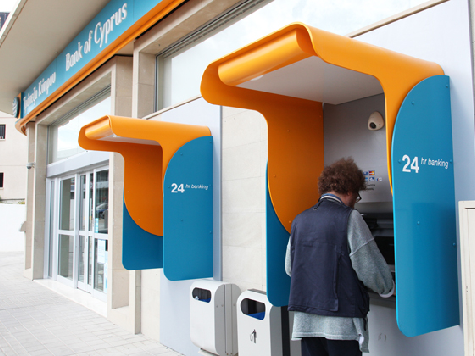
Cyprus President Nicos Anastasiades has struck a deal with the European Union and International Monetary Fund that will seize up to 40% of uninsured funds from wealthier depositors with over 100,000 euros and will not siphon funds from those below that amount.
The 10 billion euros ($13 billion) bailout plan calls for the Cyprus Popular Bank to be dissolved and all its viable assets transferred to the country’s biggest bank, Bank of Cyprus.
Cypriot banks have imposed a 100 euros ATM withdraw limit, and Cyprus border officials at air and sea ports were ordered to confiscate the funds of any traveler attempting to leave with over 10,000 euros.
Russian depositors stand to lose big, as an estimated 20 billion euros of the 68 billion euros in Cypriot banks belong to Russians.
Investors reacted with shock and dismay. “Nobody can understand how they can do this– isn’t it illegal?” said Arlene Skillett. “How can they just dock money from your account?”
Others, like Maria Zembyla, said the bailout tax is akin to theft. “It is robbery,” said Zembyla. “People like us have been working for years, saving to pay for our children’s studies and pensions and suddenly they steal a big share of this money. Russians that currently keep the economy afloat will leave the country along with their money.”
Investors around the world are nervous that Cyprus’s fiscal dysfunction may cause contagion throughout the region. Chief Morgan Stanley economist Joachim Fels said the possible deal sets “a worrying precedent with potentially systemic consequences if depositors in other periphery countries fear a similar treatment in the future.”
But while the eurozone’s Cypriot bank deal terms may be unprecedented, they are not all that different from the U.S. Federal Reserve’s policy “effectively printing more money” out of thin air to pay for federal spending the nation cannot afford while suppressing interest rates at near zero. To be sure, Cyprus and the U.S. have vastly different asset profiles. But last December, the Fed announced it would begin buying up $85 billion a month in bonds as part of a third round of so-called “quantitative easing” (QE3). The move helped balloon the Fed’s already enormous balance sheet. Since 2008, the Fed has more than tripled the size of its portfolio of assets to a record $3.189 trillion. The Fed also said it would continue to keep interest rates near zero until unemployment dropped to 6.5%. Critics say that decision effectively handed banks free money to invest elsewhere while leaving average investors with flat-lined interest rates on things like bank CDs and savings accounts–a move that, while more “orderly” than the Cypriot cash grab, is similar in principle.
As Stanford University Hoover Institution fellow Thomas Sowell points out, “When the federal government spends far beyond the tax revenues it has, it gets the extra money by selling bonds. The Federal Reserve has become the biggest buyer of these bonds, since it costs them nothing to create more money.”
Sowell continues: “This new money buys just as much as the money you sacrificed to save for years. More money in circulation, without a corresponding increase in output, means rising prices. Although the numbers in your bank book may remain the same, part of the purchasing power of your money is transferred to the government. Is that really different from what Cyprus has done?”
Jonathon Trugman, writing in the NY Post, puts it more bluntly: “The Fed has been robbing America’s poor and middle class and essentially underwriting the wealthy, the big banks and big business. The twisted maneuvers of grand larceny-like proportions have underwritten the greatest transfer of wealth this generation has ever seen.” Still, both the Fed and the Cypriot cash seizure continue.
Cypriot banks are slated to open Thursday with capital controls firmly in place.

COMMENTS
Please let us know if you're having issues with commenting.